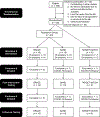Functional Resistance Training Improves Thigh Muscle Strength after ACL Reconstruction: A Randomized Clinical Trial
- PMID: 35551165
- PMCID: PMC9481660
- DOI: 10.1249/MSS.0000000000002958
Functional Resistance Training Improves Thigh Muscle Strength after ACL Reconstruction: A Randomized Clinical Trial
Abstract
Purpose: Quadriceps weakness is common after anterior cruciate ligament (ACL) reconstruction, resulting in prolonged disability and increased risk for reinjury and osteoarthritis. Functional resistance training (FRT) combines resistance training with task-specific training and may prove beneficial in restoring quadriceps strength. The primary purpose of this study was to determine if a walking-specific FRT program (e.g., resisted walking) improves knee strength in individuals after ACL reconstruction.
Methods: Thirty participants were randomized into one of three groups: 1) FRT with a customized knee BRACE applied to the ACL leg, 2) FRT with elastic BAND tethered to the ankle of the ACL leg, or 3) a TARGET MATCH condition where no resistance was externally applied. Participants in all groups received training while walking on a treadmill 2-3 times per week for 8 wk. Isometric knee extension and flexion strength were measured before the start of the intervention, after the intervention (POST), and 8 wk after intervention completion (POST-2).
Results: The BRACE group had greater knee extensor strength compared with the TARGET MATCH group at POST and POST-2 ( P < 0.05). The BRACE group had greater knee flexor strength than the TARGET MATCH group at POST and POST-2 ( P < 0.05) and the BAND group at POST ( P < 0.05).
Conclusions: FRT applied via a customized knee brace results in improvements in knee extensor and flexor strength after ACL reconstruction. FRT is a beneficial adjuvant to ACL rehabilitation and leads to better strength compared with standard of care.
Copyright © 2022 by the American College of Sports Medicine.
Conflict of interest statement
Conflict of Interest
None of the other authors report any conflict of interest for the current study. The results of the study are presented clearly, honestly, and without fabrication, falsification, or inappropriate data manipulation. The results of the present study do not constitute endorsement by the American College of Sports Medicine.
Figures





References
-
- Kuenze C, Pietrosimone B, Lisee C et al. Demographic and surgical factors affect quadriceps strength after ACL reconstruction. Knee Surg Sports Traumatol Arthrosc 2019;27(3):921–30. - PubMed
-
- Palmieri-Smith RM, Thomas AC, Wojtys EM. Maximizing quadriceps strength after ACL reconstruction. Clin Sports Med 2008;27(3):405–24, vii-ix. - PubMed
Publication types
MeSH terms
Grants and funding
LinkOut - more resources
Full Text Sources
Medical

